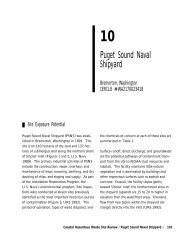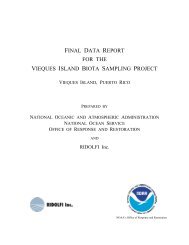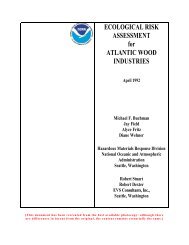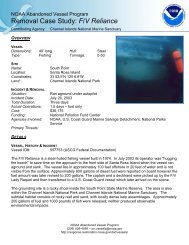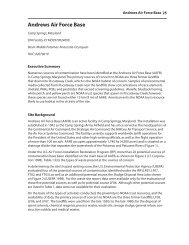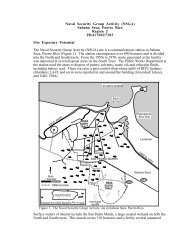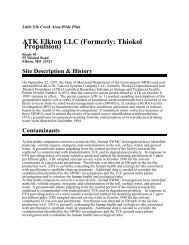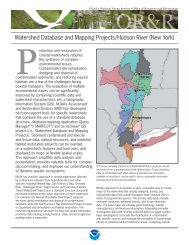The Coastal Resource Coordinator's Bioassessment Manual
The Coastal Resource Coordinator's Bioassessment Manual
The Coastal Resource Coordinator's Bioassessment Manual
You also want an ePaper? Increase the reach of your titles
YUMPU automatically turns print PDFs into web optimized ePapers that Google loves.
HAZMAT 93-1–Toxicity Tests<br />
1986; Long et al., 1990; Pastorak and Becker, 1989). However, this relative sensitivity now<br />
appears to be site or species specific (Long, personal communication). Amphipods may be<br />
more sensitive to creosote and PAHs than the Microtox ® test (Pastorak and Becker, 1989).<br />
<strong>The</strong> polychaete Neanthes appears to be sensitive to metals and PAHs (Johns, 1988). <strong>The</strong><br />
embryos and sperm cells of the sea urchin Arbacia punctulata appear to be similar to oyster<br />
larvae in their sensitivity to metals (Nacci et al., 1986).<br />
In general, only healthy organisms of similar size and life history stage should be used in<br />
toxicity tests. <strong>The</strong> organism should be appropriate for the material to be tested. For<br />
example, a planktonic or pelagic organism would be appropriate for a water toxicity test<br />
and a benthic organism would be appropriate for a sediment toxicity test. Taxonomic<br />
identifications of organisms must be confirmed by a qualified taxonomist.<br />
Acute or Chronic Testing<br />
Toxicity tests can be classified as "acute" or "chronic" tests. <strong>The</strong>se terms refer to the duration<br />
of the test with regard to the life cycle of the organism being tested, not to the endpoint of<br />
the test. However, there is no universal agreement on the precise definition of these terms.<br />
For short-lived organisms, for example, daphnids, choronimids, and amphipods, the<br />
definitions are fairly straight forward and universally accepted: an acute test is one that is<br />
completed within a small portion of the organism's life cycle, while a chronic test exceeds<br />
at least one life cycle (Chapman, 1989). <strong>The</strong> problem with the definitions arises when longlived<br />
organisms, such as fish, are tested. This is because it is impractical to run life-cyclelength<br />
toxicity tests when the life cycle is a year or more. Even if the life cycle is only a few<br />
months, life-cycle-length tests would be impractical on a routine basis. <strong>The</strong>refore the<br />
question is: how long must the duration of a test be for it to be considered a chronic test<br />
when it is impractical to run it for one or more life cycles <strong>The</strong>re is currently no generally<br />
accepted answer to the question.<br />
Endpoints<br />
<strong>The</strong> endpoint of a toxicty test is the response of the organism that is used as a measure of<br />
toxicity. Endpoints can be classified as "lethal" or "sublethal." <strong>The</strong> only lethal endpoint is<br />
the death of the test organism and is reported as either percent survival or percent<br />
mortality. Sublethal endpoints do not involve the death of the test organism but are<br />
responses that could affect the survival of in situ populations. Sublethal endpoints include:<br />
developmental abnormalities, behavioral changes, changes in reproductive success, and<br />
physiological responses reflecting changes in enzyme activity and growth rates. While<br />
3-9 August 1997




